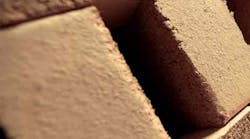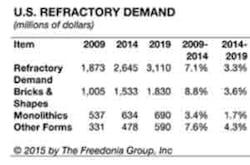Demand for refractories by U.S. manufacturers is forecast to increase 3.3% annually over the current five-year term, rising to $3.1 billion through 2019. This will represent a deceleration in the rate of expansion from the 2009-2014 period, specifically because of a declining volume in domestic iron and steel production.
The forecast and market analysis are drawn from Refractories, a new study by The Freedonia Group Inc., a Cleveland-based industry market research firm.
Sales of refractories will be limited as well by moderating output in a number of other durable goods manufacturing industries, many of which use refractories in some application.
The study also identifies a shift in manufacturers’ demand, toward better performing refractories, which it noted will provide an initial boost to sales due to their premium prices but will cause market growth to slow in the long run, as replacement cycles are lengthened.
The analysis also finds evidence of continued increases in the price of raw refractory materials will support value gains.
Also, the nonmetallic minerals industry segment, which is expected to record the fastest market advances, uses some of the highest cost refractories, boosting overall dollar growth.
When measured in volume terms, demand increases will be much more sluggish, averaging under 1% annually through 2019. Improvements in refractory designs are making it possible for refractory consumers to use less material per ton of output.
“Nonmetallic minerals will record the fastest demand gains, supported by an acceleration in output of cement and mineral products,” according to Fredonia Group analyst Kyle Peters.
Demand for nonclay refractories will increase at a faster rate than clay refractories through 2019 — a reversal from the 2009-2014 period. Nonclay refractories typically offer a number of performance advantages that boost their use in more demanding applications, and nonclay refractory prices will rise faster than those for clay products, boosting value gains.
However, the lower cost of clay refractories ensures that they will continue to be used, especially in settings where the performance advantages of nonclay refractories are not required.
Refractories is available for sale for $5,300 from The Freedonia Group Inc. Contact Tel. 440-684-9600 or [email protected] — or visit www.freedoniagroup.com.










